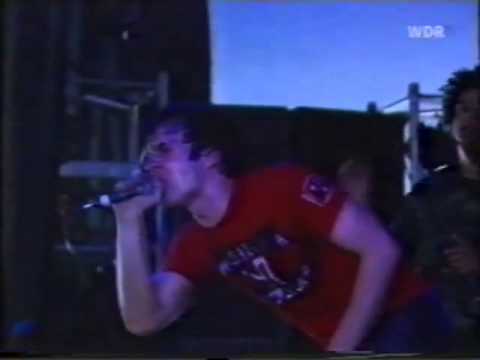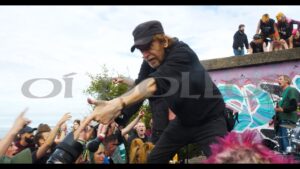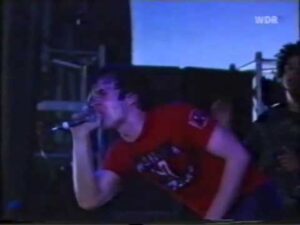Formation & Members
Atari Teenage Riot (アタリ・ティーンエイジ・ライオット), often abbreviated as ATR, was formed in Berlin, Germany, in 1992. The band was founded by Alec Empire, Hanin Elias, and Carl Crack. At the time, Berlin was an epicenter of cultural and political change, and ATR emerged as a reaction against the burgeoning neo-Nazi and right-wing movements. Alec Empire, a visionary producer and musician, sought to create a band that combined the raw energy of punk with the electronic edge of techno. Hanin Elias brought a fierce vocal presence, while Carl Crack contributed with his dynamic stage persona and lyrical prowess. Over the years, the lineup evolved, with Nic Endo joining as a permanent member in 1997, adding her own unique flair to the group.
Musical Style & Characteristics
ATR’s sound is a frenetic blend of punk, techno, and digital hardcore—a genre they largely pioneered. Their music is characterized by aggressive beats, distorted guitars, and politically charged lyrics delivered with a sense of urgency. The band’s sound is a sonic assault, often featuring rapid-fire breakbeats, heavy use of sampling, and overdriven synthesizers. Their live performances are known for their intensity, with each member bringing an unrestrained energy that matches the fervor of their recordings. Thematically, ATR’s music tackles issues such as anti-fascism, anti-capitalism, and the fight against systemic oppression, marking them as a band with a purpose beyond mere entertainment.
Key Works & Discography
Atari Teenage Riot’s discography is a testament to their pioneering spirit in the digital hardcore genre. Their debut album, Delete Yourself! (1995), set the tone for their radical approach to music and politics. Tracks like “Speed” and “Into the Death” showcased their ability to merge high-octane electronic sounds with punk ethos. Their follow-up album, The Future of War (1997), further solidified their reputation, with songs like “Sick to Death” and “Destroy 2000 Years of Culture” delivering powerful socio-political messages.
In 1999, ATR released 60 Second Wipe Out, an album that pushed the boundaries of their sound even further. This record featured collaborations with artists from diverse genres, highlighting their influence across the music spectrum. After a period of hiatus following Carl Crack’s death in 2001, ATR returned with Is This Hyperreal? in 2011, proving that their message and sound remained as relevant and revolutionary as ever.
Influence on Other Bands/Scenes
Atari Teenage Riot has had a profound influence on a wide array of artists and musical scenes. Their pioneering of the digital hardcore genre inspired numerous bands within the electronic and punk communities. The band’s fearless fusion of genres and their commitment to political activism paved the way for artists who seek to combine music with a message. Bands like Refused and The Prodigy have drawn inspiration from ATR’s energetic performances and uncompromising stance against societal injustices. ATR’s impact extends beyond music, influencing fashion, visual arts, and the broader cultural landscape, particularly in their advocacy for anti-fascist movements and digital rights.
Breakups or Reunions
ATR has experienced several hiatuses and lineup changes throughout their career. The band initially disbanded in 2000, shortly before the tragic death of Carl Crack in 2001. This marked a significant turning point, and for a time, it seemed that ATR had reached the end of their journey. However, in 2010, Alec Empire and Nic Endo announced the band’s return, joined by new member CX Kidtronik. This reunion brought a fresh energy to the group, allowing them to reach new audiences while staying true to their roots. The band has since continued to perform and release music, maintaining their status as a formidable force in the music world.
Current Reputation & Legacy
Today, Atari Teenage Riot is regarded as a seminal band within the punk and electronic music scenes. Their innovative approach to music and their unwavering commitment to their political ideals continue to resonate with fans and musicians alike. ATR’s ability to evolve while maintaining their core principles has ensured their place in music history as pioneers of digital hardcore. Their influence is evident in the continued emergence of bands that blend genres and challenge societal norms, carrying forward ATR’s legacy of defiance and innovation.
Conclusion
Atari Teenage Riot’s journey is one of relentless innovation and unapologetic activism. From their formation in the politically charged atmosphere of 1990s Berlin to their ongoing influence on contemporary music, ATR has left an indelible mark on the punk and electronic music landscapes. Their ability to blend aggressive sounds with radical messages has inspired countless artists and activists, ensuring that their legacy will endure for years to come. As they continue to perform and inspire new generations, Atari Teenage Riot remains a powerful testament to the enduring power of music as a vehicle for change.






